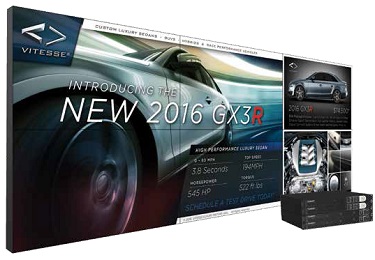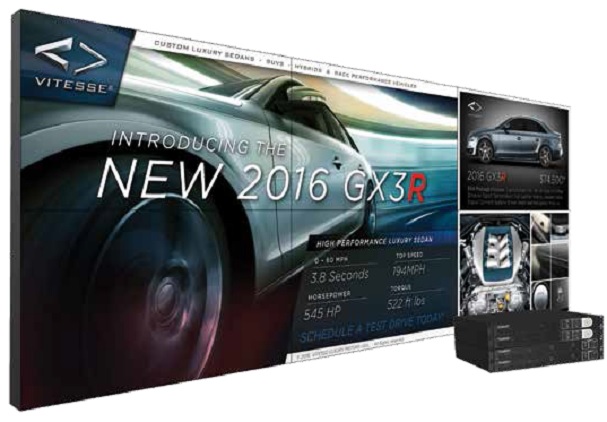It wasn’t long ago when digital signage was being sold as a way to reduce printing costs, and to update information in a timely manner. Digital panels were essentially very expensive posters. Recent innovations in display and software technologies have transformed the use of digital signage as a medium.
For retail marketers, creating visual experiences to engage customers is not new. But when brilliant creative teams are armed with new digital signage display technologies, and customized digital tools—magic happens.
THE MEDIUM AND MESSAGE

When tiled together to create a video wall, the Planar 55-inch Clarity Matrix MX55HDX with extreme narrow bezel provides a tiled bezel width of just 1.6 millimeters or less than one-sixteenth of an inch, creating a cohesive, high-impact viewing experience. Some of the world’s largest marketing agencies are creating new departments for an opportunity to shape and touch more of the customer buyer’s journey. One such agency is DCI-Artform, a Marmon/Berkshire Hathaway Company whose clients are among the Fortune 100 global companies. Digital signage is among one of the mediums used to develop and deliver retail marketing solutions and environments that engage, inform, and convert consumers into buyers.
Converting consumers into buyers is anything but passive. Kim Alpert, director of Creative Technology at DCI-Artform, oversees the digital experiences from concept through delivery, from design and user experience to interaction. “We are starting to see the use of digital signage in really smart and new ways,” Alpert said. “Digital allows for a singular moment to have the ability to captivate into a nonlinear experience and take someone out of their moment and on a journey.”
Custom controllers, sensors, and less traditional media models are where bigger ideas can flourish, Alpert noted. “Transparent interactive screens are one of my favorite things happening in our space right now.” With the cost becoming more reasonable, Alpert is looking at this as a solution for augmented reality (AR), because the viewer does not need to do anything. “There has been such an incredible opportunity to craft stories with AR, but adoption on platforms and using mobile has been difficult,” Alpert said. Transparent, interactive screens opens-up that style of storytelling.
Planar Systems, a Leyard Company, recently introduced its Planar LookThru OLED transparent display. “Transparent Organic Light Emitting Diode (OLED) technology overcomes one of the major hurdles to transparent LCD display adoption by making it possible to create truly see-through installations unobstructed by enclosures that sit behind the displays,” said Jennifer Davis, vice president of marketing and product strategy at Planar Systems and chief marketing officer at Leyard.
MEASURE IT
Experiential digital signage is infinitely more measureable than static or even digital signage of the past, because interactions themselves can be counted and provide valuable data, Davis pointed out.
“These data sources can provide valuable insight into brands about how often their interactive digital signage is engaged, and how it ties into other initiatives like mobile and social marketing,” Davis said. “They can now track user sessions, duration of engagement, number of clicks or shares, and they can ‘heat map’ the application to provide insight into the most popular (or least popular) features of the experience, and to provide opportunities for improvements to the user interface.” This aligns with what retailers, advertising networks, and others expect regarding measuring ROI.
Richard Daugherty, digital media solutions engineer, at design and integration firm AVI-SPL, added, “Digital signage provides a platform for customers or viewers to give feedback; their product reviews or answers to surveys can be displayed on your screens.” This validates to the customer that they’re being heard.
With a different perspective on measuring the investment, Saundra Merollo, senior sales engineer of Enterprise Accounts, at Sharp Imaging & Information Company of America suggested, “When it comes to digital signage, look at Return on Objective (ROO), instead.” In this case content is developed based on what type of consumer behavior a brand is trying to drive. “The way to drive that behavior is to make that brand relatable to the audience. For instance, if you are used to working on a tablet at home, you are more likely to relate better to a touch-screen display at work. This is comfortable for you and easy to use, so you will more likely use it. So if the type of consumer behavior you want to drive is to use the product, then that ROO has been met.”
A happy customer is one of the best measurements of success. “In the end, if you want to change customer behavior, it comes down to enhancing customer service,” Merollo said. “Statistics have proven that providing messaging on digital signage when a consumer is waiting for a service greatly improves the perceived customer service and reduces the perceived wait time.” Merollo cited a large-chain moving company as an example. “The biggest problem was customer experience because of the wait. Sales went up 35 percent when that customer deployed digital signage,” she said. “The wait times are even longer now, but the perception is a lot less.”
FORM FACTOR
Whether in the form of a flat panel, a projector, a multi-touch panel, transparent, or curved display; the world of digital signage has been transformed.
As quickly as creative teams embrace the seemingly limitless forms of the digital signage medium, display manufacturers are developing new technologies, formats and overall categories of displays. “This allows marketers and designers to create unique and immersive display environments for their customers,” said Garry Wicka, head of marketing, at LG Commercial Displays. “You’re starting to see designers utilize new spaces that had not previously been part of their digital strategy.”
LG is certainly doing its part to offer new technologies and form-factors. LG recently announced its 86-inch Ultra Stretch digital signage solution (86BH5C) which moves away from the standard 16:9 format to a whopping 58:9 format providing a 7-foot long, “stretched” display.
There has been is an overall acceleration in innovations in the display market. “We have seen the introduction of large LED video walls with pixels small enough to be viable for indoor use, development of better outdoor LCD displays,” said Wicka. However, he sees the biggest innovation coming in the form of OLED technology. “New OLED technology presents many advantages that will certainly change the way that digital signage and overall commercial displays are viewed and deployed.”
Figuratively and literally, LG’s OLED displays are flexible. “A curved OLED truly does have that cool aesthetic factor, which is something that you really have to take into account,” said Garry Wicka, head of marketing, at LG Commercial Displays. “The main purpose of digital signage is to capture viewers’ attention and then serve as a conduit for the sharing of information.”
Larger video wall displays, interactive display technologies, and transparent displays are all advancing experiential marketing in digital signage, noted Planar’s Davis. “Video walls have come down in price, while increasing in visual performance and functionality, driving higher adoption. Interactive touch sensors have become more common both in video walls and in large format displays, like the latest UHD or 4K displays. Add to that the emergence of transparent displays and, we will see new opportunities for experiential marketing abound.”
By the end of 2016 we are sure to see more new digital signage technology and display announcements from various companies. Commercial applications often follow consumer adoption; and for more than a year some consumers in Japan have be watching 8K TV in their homes. We already hear the buzz.
Info
avispl.com
dciartform.com
lg.com/us/commercial
planar.com/lookthru
siica.sharpusa.com

